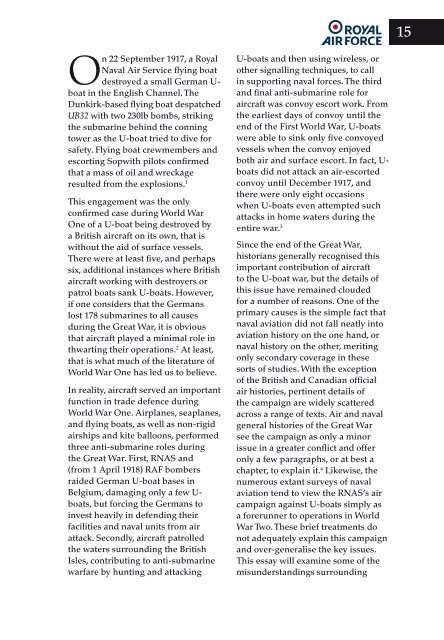Create successful ePaper yourself
Turn your PDF publications into a flip-book with our unique Google optimized e-Paper software.
On 22 September 1917, a Royal<br />
Naval <strong>Air</strong> Service flying boat<br />
destroyed a small German Uboat<br />
in the English Channel. The<br />
Dunkirk-based flying boat despatched<br />
UB32 with two 230lb bombs, striking<br />
the submarine behind the conning<br />
tower as the U-boat tried to dive for<br />
safety. Flying boat crewmembers and<br />
escorting Sopwith pilots confirmed<br />
that a mass of oil and wreckage<br />
resulted from the explosions. 1<br />
This engagement was the only<br />
confirmed case during World War<br />
One of a U-boat being destroyed by<br />
a British aircraft on its own, that is<br />
without the aid of surface vessels.<br />
There were at least five, and perhaps<br />
six, additional instances where British<br />
aircraft working with destroyers or<br />
patrol boats sank U-boats. However,<br />
if one considers that the Germans<br />
lost 178 submarines to all causes<br />
during the Great War, it is obvious<br />
that aircraft played a minimal role in<br />
thwarting their operations. 2 At least,<br />
that is what much of the literature of<br />
World War One has led us to believe.<br />
In reality, aircraft served an important<br />
function in trade defence during<br />
World War One. <strong>Air</strong>planes, seaplanes,<br />
and flying boats, as well as non-rigid<br />
airships and kite balloons, performed<br />
three anti-submarine roles during<br />
the Great War. First, RNAS and<br />
(from 1 April 1918) RAF bombers<br />
raided German U-boat bases in<br />
Belgium, damaging only a few Uboats,<br />
but forcing the Germans to<br />
invest heavily in defending their<br />
facilities and naval units from air<br />
attack. Secondly, aircraft patrolled<br />
the waters surrounding the British<br />
Isles, contributing to anti-submarine<br />
warfare by hunting and attacking<br />
U-boats and then using wireless, or<br />
other signalling techniques, to call<br />
in supporting naval forces. The third<br />
and final anti-submarine role for<br />
aircraft was convoy escort work. From<br />
the earliest days of convoy until the<br />
end of the First World War, U-boats<br />
were able to sink only five convoyed<br />
vessels when the convoy enjoyed<br />
both air and surface escort. In fact, Uboats<br />
did not attack an air-escorted<br />
convoy until December 1917, and<br />
there were only eight occasions<br />
when U-boats even attempted such<br />
attacks in home waters during the<br />
entire war. 3<br />
Since the end of the Great War,<br />
historians generally recognised this<br />
important contribution of aircraft<br />
to the U-boat war, but the details of<br />
this issue have remained clouded<br />
for a number of reasons. One of the<br />
primary causes is the simple fact that<br />
naval aviation did not fall neatly into<br />
aviation history on the one hand, or<br />
naval history on the other, meriting<br />
only secondary coverage in these<br />
sorts of studies. With the exception<br />
of the British and Canadian official<br />
air histories, pertinent details of<br />
the campaign are widely scattered<br />
across a range of texts. <strong>Air</strong> and naval<br />
general histories of the Great War<br />
see the campaign as only a minor<br />
issue in a greater conflict and offer<br />
only a few paragraphs, or at best a<br />
chapter, to explain it. 4 Likewise, the<br />
numerous extant surveys of naval<br />
aviation tend to view the RNAS’s air<br />
campaign against U-boats simply as<br />
a forerunner to operations in World<br />
War Two. These brief treatments do<br />
not adequately explain this campaign<br />
and over-generalise the key issues.<br />
This essay will examine some of the<br />
misunderstandings surrounding<br />
15

















